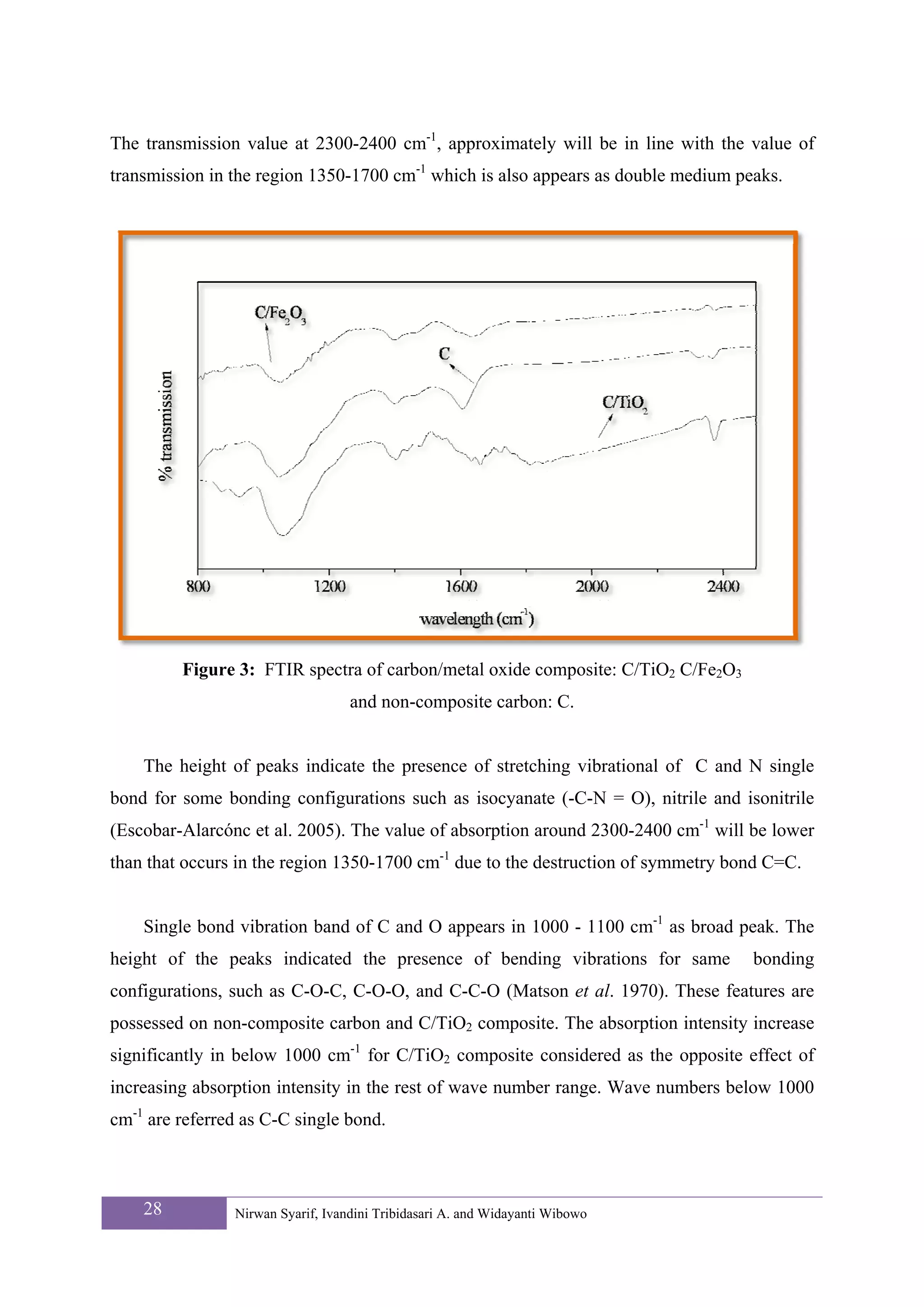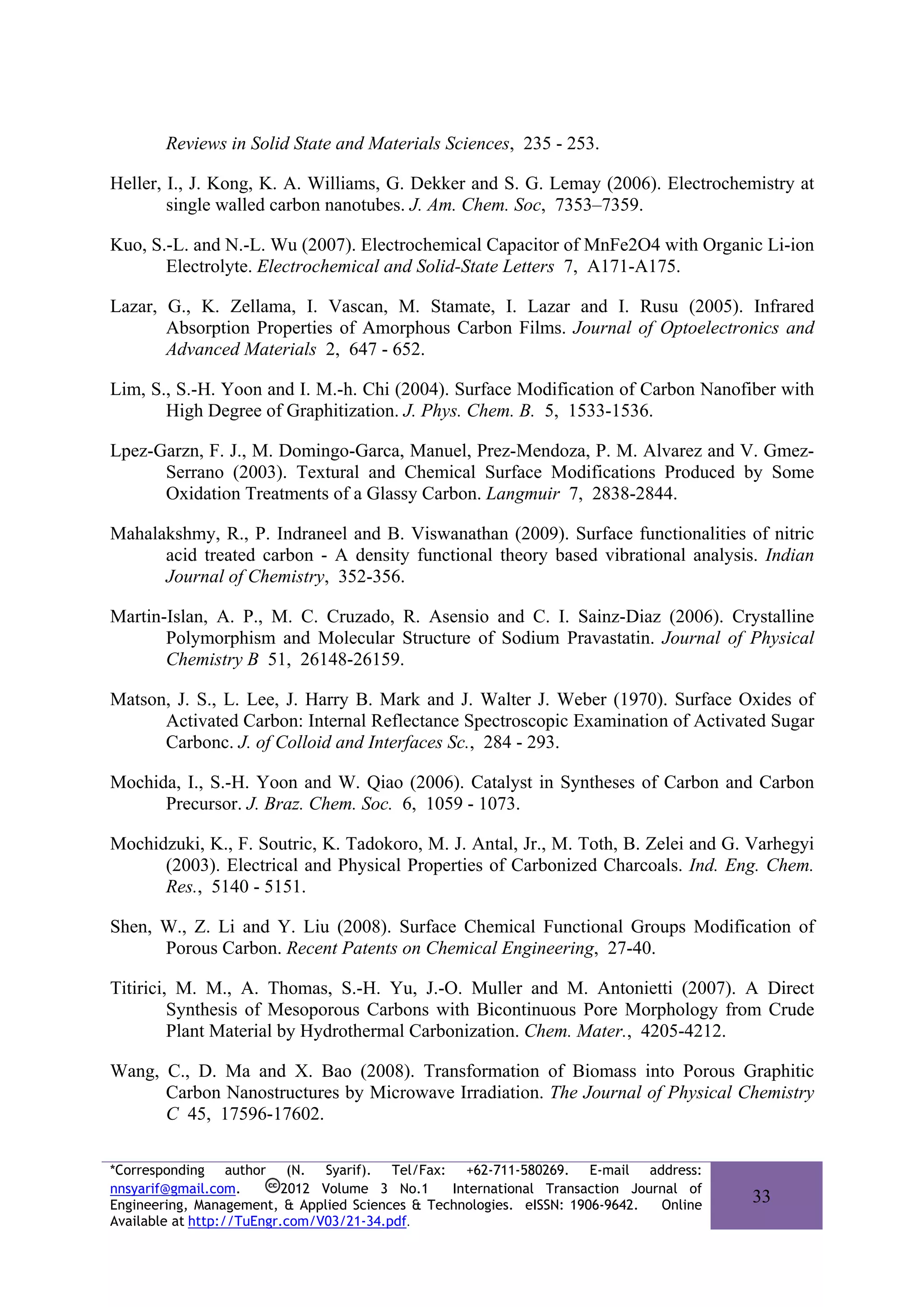This study investigates the synthesis of carbon/metal oxide composites from gelam wood for electrochemical capacitor electrodes, focusing on the effects of transition metal salts as activators and substrates. The researchers modified the surface functionalities of activated carbons through oxidative treatments, analyzing their structures and electrochemical properties using XRD and FTIR techniques. Results indicate that the crystallographic and surface properties, influenced by the synthesis methods, significantly affect electrical conductivities and electrochemical performance of the composites.


![In this work, gelam wood (paper-bark wood, Melaleuca cajuputi Powell) sawdust was
used to prepare activated carbons using chemical activator i.e. transition metal salts which
also act as composite precursors. A number of materials with different structures and surface
functionalities have been obtained.
Surface functionalities of the activated carbon were modified by heating in concentrate
nitric acid under reflux and by aging under hydrothermal condition. All carbons were applied
as working electrode in the three electrodes system using acidic and basic aqueous medium,
H2SO4 and KOH respectively. The materials were characterized in terms of crystallographic,
surface chemistry and electrical conductivity. TEM was used to evaluate the size of carbon
particles and metal loading in carbon samples.
2. Materials and Methods
The sawdust particles were screened through 100 mesh wire sieved and treated with 20%
HCl for 1 day, filtered, washed with demin-water then dried over night at 110oC. Sawdust
particles were impregnated with solution of transition metal, i.e TiCl3 or FeCl3 and then were
heat-treated under N2 atmosphere at 700oC for 8-10 hours. The obtained carbon samples were
considered as the composite of carbon and metal oxide. Carbon/metal composite were
oxidized in concentrated nitric acid under reflux or under pressurized water vapor in the
hydrothermal reactor. The nitric acid oxidation was carried out at 60°C for 3 hours as
described by Mahalakshmy et al. (2009) and the hydrothermal process was conducted at
200°C for 16 hours (Titirici et al. 2007). The products were separated by centrifuge and
washed with abundant demin-water.
Structural change was detected chemically with FTIR and XRD patterns. X-ray
diffraction (XRD) patterns of the carbons were obtained on a Shimadzu X-ray diffractometer
XRD 7000 operating at 40 kV and 30 mA, using Cu-Kα radiation. All XRD spectra were
analyzed with X-Powder software (ICDD) to obtained quantitative value for crystallographic
parameter (Martin-Islan et al. 2006). Plane spacing (d002) was calculated by applying Bragg’s
equation to the [002] diffraction peak, while the crystallite sizes along the c-axis, Lc, and a-
axis, La, were deduced by Scherrer’s equation applied to the [002] and the [100], [110]
*Corresponding author (N. Syarif). Tel/Fax: +62-711-580269. E-mail address:
nnsyarif@gmail.com. 2012 Volume 3 No.1 International Transaction Journal of
Engineering, Management, & Applied Sciences & Technologies. eISSN: 1906-9642. Online
23
Available at http://TuEngr.com/V03/21-34.pdf.](https://image.slidesharecdn.com/21-34-120419000012-phpapp01/75/Direct-Synthesis-Carbon-Metal-Oxide-Composites-for-Electrochemical-Capacitors-Electrode-3-2048.jpg)
![diffraction peaks, respectively (Awitdrus et al. 2010). FTIR spectra were obtained on
Shimadzu IR Prestige 21. The dispersion of metal loading in carbon and the size of the carbon
particles were evaluated by the TEM micrographs. TEM micrographs were obtained on JEM-
1200EX.
The EC electrodes were fabricated by mixing the composite powder with PTFE binder
(Merck, 99%) in isopropanol (Merck, 99%). 20 drops of triethanolamine (TEA) were added
into the mixture. Circular electrodes were obtained from 1.5 g of mixture paste in a 20 mm
diameter mold, and pressed under 3 tons load and the molded pastes were heated at 300°C on
a hot plate for an hour and removed from mold after being cooled.
Electrochemical test for the electrodes were conducted using cyclic voltammetry
technique in three electrodes configuration potentiostat. Ag/AgCl electrode was used as
reference electrode and Platinum rod was used as the counter electrode. Considering that the
anodic voltammetric charges and cathodic voltammetric charges are not the same in the shape
of voltammogram curve, the average specific capacitance of the electrode was calculated
using integral area approximation (Kuo et al. 2007)
Cavg =
ΔQ
=
(
∫ IdV ) [1]
( w × ΔV ) ( s × ΔV × w)
Where ΔQ is the total amount of the charge accumulated over a potential window, ΔV ,
w is the mass of active material in one electrode, I is the current, and s is the potential scan
rate. Hence ( ∫ IdV ) is integral area of voltammogram curve.
3. Results and Discussion
Sawdust particles impregnated with metallic salt were treated by heating in nitrogen
atmosphere, metal salt decomposed into the corresponding metallic oxides, which were
subsequently reduced the mass of composites (Encinar et al. 1997; Antal et al. 2003). As the
temperature rise, the carbon came close to metal particles.
These particles have diameters in the range of 10-50 nm and built some clusters. This
features were revealed by the TEM image obtained for the carbon/Fe2O3 composite (Figure
24 Nirwan Syarif, Ivandini Tribidasari A. and Widayanti Wibowo](https://image.slidesharecdn.com/21-34-120419000012-phpapp01/75/Direct-Synthesis-Carbon-Metal-Oxide-Composites-for-Electrochemical-Capacitors-Electrode-4-2048.jpg)
![1A). Carbons with nanoporous were formed around the metal oxide particles through a
catalytic mechanism that involved the dissolution of amorphous carbon into the catalyst
particles followed by the precipitation of graphitic carbon. Figure 1a shows the metal oxide
particles, which were surrounded by graphitic carbon shells. The thickness of the carbon layer
for these nanostructures was in the range of 10-17 nm, which was in good agreement with the
Lc values estimated from the analysis of the XRD patterns. The distinction between carbons
and metal oxide particles were clearly shown. In the background, carbon structures were
mixed with cluster of metal oxide particles. During the thermal treatment at 700 °C, only the
carbon in contact with the metal oxide particles was converted into carbon nanostructures, the
rest of the material remained as amorphous carbon. Consequently, the carbonized material
contains organized carbon mixed with non-organized carbon. This is clearly shown in Figure
1B where both structures were displayed.
The XRD diffraction patterns of the carbon/metal oxide composite (figure 2) confirm that
the carbon materials contained a few amorphous phase. In fact, the non-composite carbon
samples prepared from the same precursor exhibit intense XRD peaks at 2θ = 15°, 28° and
45o which respectively correspond to the [100], [011] and [002] diffractions of the graphitic
framework.
The crystallographic parameters of the carbons were deduced from the analysis of the
XRD spectra. Thus, the plane spacing (d002) was calculated by applying Bragg’s equation to
the [002] diffraction peak, while the crystallite sizes along the c-axis, Lc, and a-axis, La, are
deduced by Scherrer’s equation applied to the [002] and the [100], [110] diffraction peaks,
respectively. Values of these parameters are presented in Table 1 and Table 2.
The d-spacing values are presented for [002] reflections indicate the distance between
layer planes. Samples synthesized with catalyst have lower values for crystallite size and d-
spacing. Carbon in Carbon/Fe2O3 composite was smaller (5 Ǻ) than non-composite carbon
(5.3 Ǻ). Nevertheless all d-spacing values of carbon samples which were 5-6 Ǻ, indicated the
layer planes were not registered but simply parallel without three-dimensional order also
known as turbostratic stacking. La and Lc confirmed that carbons and carbon/metal oxide
composite were composed of many quasi-graphitic crystallites.
*Corresponding author (N. Syarif). Tel/Fax: +62-711-580269. E-mail address:
nnsyarif@gmail.com. 2012 Volume 3 No.1 International Transaction Journal of
Engineering, Management, & Applied Sciences & Technologies. eISSN: 1906-9642. Online
25
Available at http://TuEngr.com/V03/21-34.pdf.](https://image.slidesharecdn.com/21-34-120419000012-phpapp01/75/Direct-Synthesis-Carbon-Metal-Oxide-Composites-for-Electrochemical-Capacitors-Electrode-5-2048.jpg)








